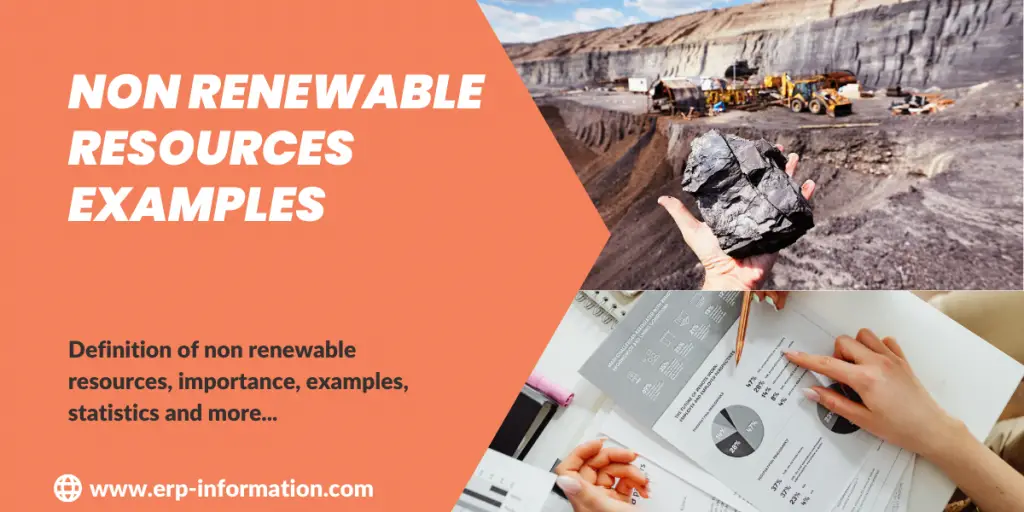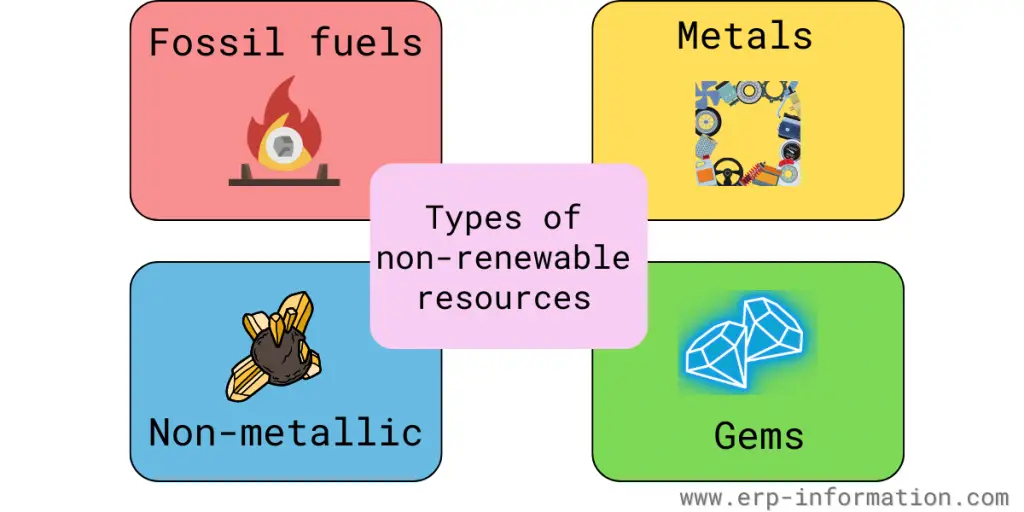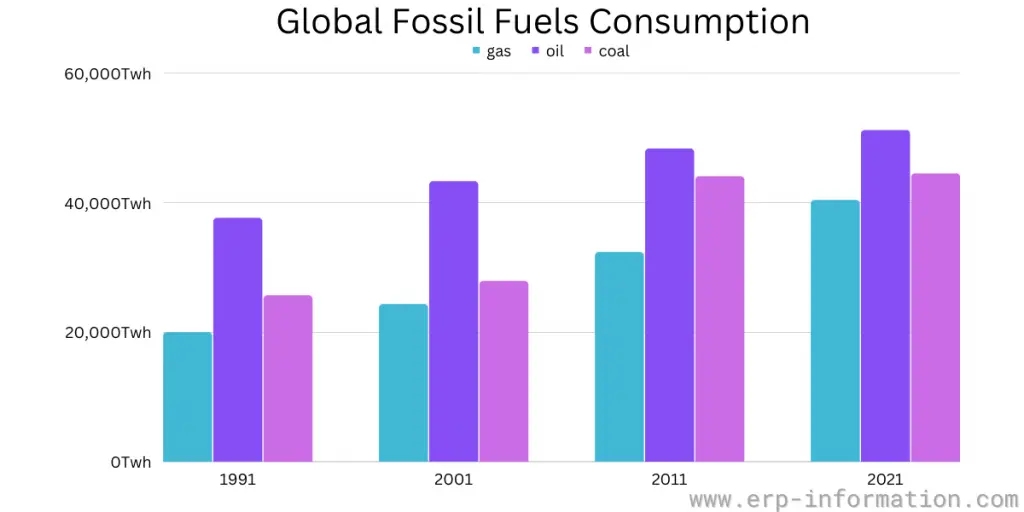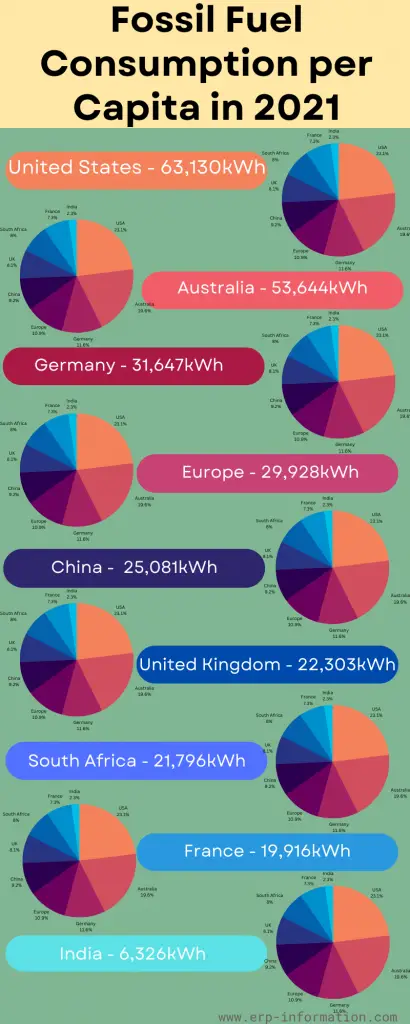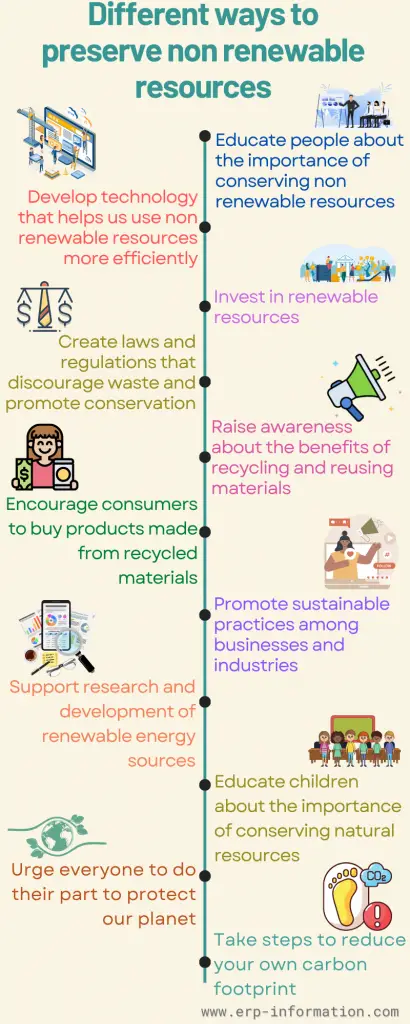Non renewable resources are those that we cannot create more of. Once they’re gone, they’re gone for good. So it’s important to learn about these resources, their worldwide consumption, current consumption rate, and how to use them sustainably to preserve them for future generations.
In this blog post, we’ll discuss what non-renewable resources are, non renewable resources examples, their importance, their worldwide consumption, and discuss how to preserve them. We’ll also look at reducing our dependence on these finite resources.
What is a non-renewable resource?
Non-renewable resources are those that cannot be replaced once they have been used. Nonrenewable resources include fossil fuels like coal, oil, and natural gas and mining materials such as gold, silver, and copper.
These resources are often used to produce energy or to build things such as cars and phones.
It is important to use non-renewable resources sparingly so that they can last for a long time. Some ways to help preserve nonrenewable resources include recycling and using less energy.
Non renewable resources examples
Non-renewable resources are used in various ways, including energy production, manufacturing, and construction. Non-renewable resources are finite, meaning they are not naturally replenished and will eventually run out. Here we are listing some important non renewable resource examples.
What are the different types of non-renewable resources?
There are different types of non-renewable resources, each with its unique characteristics. The image shows some of the most common types:
1. Fossil Fuels
Fossil fuels are materials that are burned to create energy. Coal, crude oil, and natural gas are all examples of fossil fuels. They’re called fossil fuels because they’re made from the remains of prehistoric plants and animals.
Crude Oil
It is one of the nonrenewable resources used most widely. It’s made up mostly of hydrocarbons and other organic compounds. It is a fossil fuel that is extracted from the ground and then refined into various products like gasoline, diesel fuel, kerosene, and plastics.
Nonrenewable energy sources like oil can be used to generate electricity or to power machinery. Most of the world’s oil comes from the Middle East and Russia.
- The United States consumes an average of 19.4 million barrels of oil every day.
- In 2021 an average of 3.94 million b/d (669 million gallons per day) of distillate fuel will be consumed, equaling 29% of total U.S. petroleum consumption.
- The transportation sector consumes 70% of Diesel.
Worldwide crude oil consumption
- Transportation 49.3%
- Industrial 7.2%
- Residential 5.4%
If we use crude oil at the same consumption rate, it will last after 51 years.
Natural gas
It is another nonrenewable resource. It is a fossil fuel often found in underground reservoirs and extracted using drilling or fracking methods. It’s used for heating and cooking, and to produce electricity. Natural gas is also used in the production of fertilizers and plastics. Russia, Iran, Qatar, and the United States have the largest natural gas deposits.
Worldwide natural gas consumption in the year 2021 was 4.04 trillion cubic meters, according to Statista.
If we use natural gas at the same consumption rate, it will last after 53 years.
Coal
It is a fossil fuel mined from the ground to produce energy. Coal is made from dead plant material that has been compressed over millions of years. It is often used in power plants to generate electricity and in certain industrial processes such as steel production.
- The World Coal Association informs that we have sufficient coal for the next 150 years with current consumption rates.
- The coal used in the following sectors
- Industry
- Transportation
- Residential
- Commercial
- Agriculture
- Fishing
Another source tells if we use coal at the same consumption rate, it will last after 144 years. But according to International Energy Agency (IEA), coal consumption will reduce in upcoming years because of the increased usability of renewable resources.
Nuclear energy, or nuclear fuel
It is a nonrenewable resource used to generate electricity. Nuclear power plants use uranium, a radioactive element, as fuel to generate heat which is then converted into electricity.
Uranium can be found naturally in soil or ore deposits and produced synthetically for fuel in nuclear power plants. Nuclear fuels can also be used for medical and military applications.
- According to Nuclear Energy Agency, we have enough Uranium supply for the next 200 years with today’s consumption rate.
- Uranium is used in about 11% of all energy sources worldwide.
- We use uranium as a shielding material in some containers that store and transport radioactive materials.
2. Metals
Metals are materials used to make things like cars, computers, and jewelry. They’re called metals because they’re a group of metallic luster elements. Some common metals include copper, aluminum, and gold.
Gold
Minerals such as gold or silver are also considered nonrenewable resources. These minerals are found in the earth’s crust and mined to be used in various industries such as building bridges, aircraft, manufacturing electronics, medical equipment, and more.
- Every year 2700 tons of gold is mined.
- It is used in cell phones, computers, and other high-tech devices as it is a great electricity conductor.
Aluminum
According to Statista, aluminum consumption worldwide was 64.2 million metric tons in 2021, and it is 65.86 million metric tons in 2022. It is projected that aluminum consumption will be 71.14 million metric tons in 2025. That means consumption keeps on increasing.
Copper
As per Statista, worldwide copper consumption is also increasing. Consumption was 23.6 million metric tons in 2019, 24.4 million metric tons in 2021, and in 2022, consumption is 25.1 million metric tons.
3. Nonmetallic Minerals
Nonmetallic minerals are materials that don’t have a metallic luster. Some examples include sand, limestone, and marble. Nonmetallic minerals have a lot of different uses, including construction materials and fertilizers.
4. Gems
Gems are materials that are used to make jewelry. Diamonds, rubies, and sapphires are all examples of gems. Gems come from two different places: mines and water environments. Mines are where gems are usually found near the surface of the earth.
Water environments are where gems form when dissolved minerals precipitate out of water and form crystals.
Diamond
It is a nonrenewable resource that is mined from the earth. It is used in jewelry and other decorative items. Diamonds are prized for their hardness and beauty but have industrial uses such as cutting tools and drill bits.
Diamond is forged under extreme temperatures and pressures about 100 miles below the earth’s surface that few other substances can endure. The carbon atoms in diamonds are linked together equally in all directions. Hence it is very strong and requires another diamond even to scratch.
Diamond is used to make Diamond windows, Diamond speaker domes, heat sinks, etc.
These are just some of the different types of nonrenewable resources. Nonrenewable resources can be found worldwide, and they are essential to our modern lifestyle. But it’s important to remember that these materials are finite and cannot be replaced once they’re used.
Hence it is important to use nonrenewable resources responsibly. That means reducing consumption, implementing more efficient practices, and investing in renewable energy sources like solar, wind, and geothermal power.
So to help preserve them, people should practice responsible resource management techniques such as reducing, reusing, and recycling materials. That will help ensure that these resources are available for future generations.
Why is it important to preserve non-renewable resources?
Non-renewable resources are important to preserve because they are finite natural resources. Once they are gone, there will be no other resources, which means they are gone forever. Non-renewable resources are also important to preserve because they can be used to create energy.
For example, non-renewable resources are used to create both electricity and heating. These resources also provide important raw materials for manufacturing, construction, and other industries. Nonrenewable resources can also be used to manufacture essential products like cars, planes, and computers.
Preserving non-renewable resources helps protect the environment by reducing our reliance on fossil fuels and other harmful substances. Non-renewable resources are also an important part of the global economy, providing jobs and income for many people.
However, if non-renewable resources are not managed properly, they can be depleted quickly and without replacement, leading to economic instability in some areas.
Different ways to preserve non renewable resources
Educate people about the importance of conserving non renewable resources
The most effective way to preserve non renewable resources is by educating people about their importance. Non renewable resources are finite and eventually run out, so teaching people how to conserve them through responsible consumption and recycling is important.
Develop technology that helps us use nonrenewable resources more efficiently
Nonrenewable resources can be used more efficiently by developing and using technology such as energy-efficient appliances or alternative energy sources. These technologies help us reduce the number of resources we use so that they last longer.
Invest in renewable resources
Nonrenewable resources should be replaced with renewable ones wherever possible. Investing in renewable resources and technologies such as solar, wind, and geothermal energy can help reduce the need for fossil fuels and other non-renewable sources.
Create laws and regulations that discourage waste and promote conservation
Governments should create laws and regulations that discourage the waste of non renewable resources. That includes encouraging sustainable consumption, promoting recycling, creating incentives for businesses to use more renewable resources, and discouraging over-consumption.
Raise awareness about the benefits of recycling and reusing materials
People should know the importance of recycling and reusing materials. That can be done through educational campaigns, events, workshops, and other initiatives targeting adults and children.
Encourage consumers to buy products made from recycled materials
Nonrenewable resources can be conserved by encouraging consumers to buy products made from recycled materials. That will reduce the demand for new materials, thus reducing the amount of resources extracted and helping conserve resources.
Promote sustainable practices among businesses and industries
Businesses and industries should be encouraged to use sustainable practices in their operations. That includes reducing energy consumption, using renewable energy sources, investing in efficient technologies, and creating innovative products that help conserve resources.
Support research and development of renewable energy sources
Non-renewable resources can be conserved by supporting research and development of renewable energy sources. That will help reduce the reliance on non-renewable fuels, thus reducing the need for extracting new resources from the earth.
Educate children about the importance of conserving natural resources
Educating children about the importance of conserving Non-renewable resources is essential. That can be done through school programs, summer camps, and other initiatives to help them understand the requirement for conservation and the consequences of over-exploitation.
Urge everyone to do their part to protect our planet
Nonrenewable resource conservation can only be achieved if everyone plays a role. Everyone should take steps to reduce their consumption, switch to more sustainable habits, and join forces with others who share the same values of protecting Non-renewable resources.
Take steps to reduce your carbon footprint.
Nonrenewable resources can be conserved by reducing your consumption and carbon emissions.
That includes turning off lights when not in use, limiting energy consumption, unplugging appliances when not in use, replacing old appliances with energy-efficient models, carpooling or taking public transport instead of driving own cars, reducing plastic consumption, etc.
Nonrenewable resources are valuable assets for our environment. Conservation of these resources is essential to ensure our planet’s future sustainability.
With small changes in everyday habits, initiatives from governmental bodies, conservation efforts from non-governmental organizations, and sustainable alternatives, we can ensure that these resources will be available for future generations.
Non renewable resources vs renewable resources
| Nonrenewable resources | Renewable resources |
| They are finite natural resources. | They are infinite natural resources. |
| They take millions of years to form and can not replenish or restore in a short period. | They can replenish or restore over a short period. |
| Extraction and consumption of nonrenewable resources lead to environmental challenges such as air pollution, water pollution, land degradation, and global warming. | They are sustainable and don’t generate environmental problems. |
| Examples: Oil, Natural gas, Coal, and nuclear energy. | Examples: Solar, wind, hydroelectric, geothermal, and biomass energy. |
Note: Metals are considered as both renewable and non renewable resources. They may be considered non renewable because they are extracted from the earth. They may be considered renewable because they are plentiful and can be recycled.
How do non renewable resources affect the environment?
Non-renewable resources can significantly impact the environment due to how they are extracted, processed, and used. As a result, they cause many environmental issues, including:
Air pollution: Burning fossil fuels releases carbon dioxide, sulfur dioxide, and nitrogen oxides, contributing to smog and acid rain. These pollutants can significantly impact human health, vegetation, and ecosystems.
Water pollution: Non-renewable resources can be extracted in ways that contaminate water sources. For example, fracking for natural gas releases chemicals that can seep into groundwater, potentially contaminating drinking water sources.
Habitat destruction: Extracting non-renewable resources often involves removing large amounts of topsoil and vegetation, which can damage or destroy wildlife habitats and disrupt ecosystem function.
Climate change: Fossil fuels are the largest contributor to greenhouse gas emissions, which cause climate change. The extraction, transportation, and consumption of non-renewable resources contribute to warming the planet and impacting global weather patterns.
Land degradation: Mining non-renewable resources such as gold and iron can result in soil erosion and degradation, leading to long-term damage to the productivity and health of the land.
FAQs
How do non renewable resources affect the climate change?
Non-renewable resources contribute significantly to climate change by producing greenhouse gases when extracted, processed, and burned. Burning fossil fuels like coal, oil, and gas release carbon dioxide (CO2).
This CO2 then accumulates in the atmosphere, traps heat from the sun, and causes global warming. This process contributes to rising sea levels, melting glaciers and polar ice caps, drought, and extreme weather events, which can have serious consequences for both human and natural systems.
Conclusion
Non-renewable resources are a vital part of our lives, and knowing what they are and how to use them is crucial.
This post provided a detailed description of non-renewable resources, including examples, ways to preserve them, and important statistics about fossil fuel consumption. We hope you found this information helpful!
References
